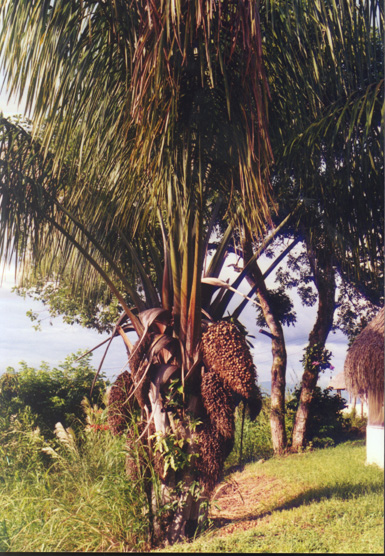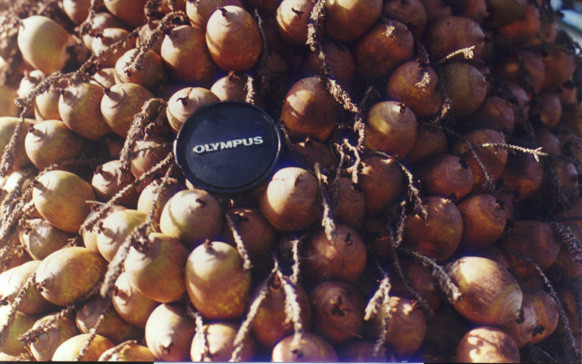AMAZONIAN PLANTS AND THEIR AMAZING USES
Attalea maripa (Aubl.)
Mart.
by F. Guánchez
L.H. Bailey Hortorium, 462 Mann Library, Cornell University, Ithaca,
NY 14853
This palm species is distributed throughout northern South America. It is
found in well-drained soils, in gallery forest, the periphery of savannas,
and particularly abundant in disturbed habitats (Henderson et al. 1995).
According to Guánchez and Romero (1998), the folk names used for this
species in the Amazonas state are: Cucurito (Spanish), Alitsi (Baniva), Okalisi
(Baré), Najjarebo (Guahibo), Kwéterri (Kurripaco), We'sae (Panare),
Wä'chä (Piaroa), Waibi (Puinabe), Okarisi (Warequena), Kereshi
kë-si and Okolaxi (Yanomami), and Washa (Yekuana).
The species belongs to the family ARECACEAE (Palmae), subfamily Arecoideae,
Tribe Cocoeae, Subtribe Attaleinae (Uhl & Dransfield 1987). It has a
solitary stem, up to 18 m high and 20 cm in diameter. (Fig. 1). Leaves 10-15,
erect to lightly arching, 5-6 m long, 170-260 leaflet pairs, grouped and
born in different planes. Inflorescence large interfoliar, peduncular bract
very large, long persistent, with a long solid beak, thick and woody. Fruit
oblong ovoid, 4-7 X 2.5-3.5 cm, yellowish brown (Fig. 2).

Fig. 1. An Attalea maripa palm tree.
Photo by Francisco Guánchez

Fig. 1. A basket made from the interwoven young fronds of
Attalea maripa.
Photo by Francisco Guánchez

Fig. 1. The edible fruits of Attalea maripa.
Photo by Francisco Guánchez
Perhaps the more important use by Piaroas and Guahibos is the utilization
of the leaves for thatching. The leaves are also used for making baskets,
known as "Katumare," used as backpacks for transporting manioc and various
other items during treks. The leaflets are used for mats and baskets used
for drying food and other items (Fig. 3). Its fruits are edible, the petioles
are used for making arrow tips, baskets, and fences for fishing traps. The
insect larvae found in fruit are used for bait. The bracts are also painted
with landscapes and sold in Puerto Ayacucho as a decorative tourist item.
BIBLIOGRAPHY
Guánchez, F., and G. Romero. 1998. Palms and Amerindian fishing in
the Amazonas State of Venezuela. Principes 42(3):125-135.
Henderson, A., G. Galeano, and R. Bernal. 1995. Field guide to the palms
of the Americas. Princeton University Press, Princeton, N.J.
Uhl, N. W. and J. Dransfield 1987. Genera Palmarum. The L.H. Bailey Hortorium
and The International Palm Society. Allen Press, Lawrence, Kansas.
return to Emanations vol.1: no.1 contents page


